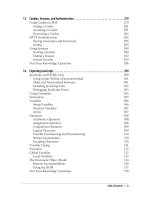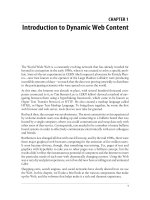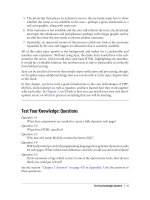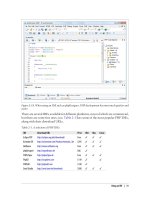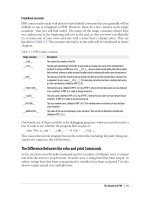Học php, mysql và javascript - p 13 pps
Bạn đang xem bản rút gọn của tài liệu. Xem và tải ngay bản đầy đủ của tài liệu tại đây (1.5 MB, 10 trang )
Here I have also used an invaluable function called print_r. It asks PHP to display
information about a variable in human readable form. The _r stands for “in human
readable format.” In the case of the new object $object, it prints the following:
User Object
(
[name] =>
[password] =>
)
However, a browser compresses all the whitespace, so the output in a browser is slightly
harder to read:
User Object ( [name] => [password] => )
In any case, the output says that $object is a user-defined object that has the properties
name and password.
Creating an Object
To create an object with a specified class, use the new keyword, like this: object = new
Class. Here are a couple of ways in which we could do this:
$object = new User;
$temp = new User('name', 'password');
On the first line, we simply assign an object to the User class. In the second, we pass
parameters to the call.
A class may require or prohibit arguments; it may also allow arguments, but not require
them.
Accessing Objects
Let’s add a few lines more to Example 5-10 and check the results. Example 5-11 extends
the previous code by setting object properties and calling a method.
Example 5-11. Creating and interacting with an object
<?php
$object = new User;
print_r($object); echo "<br />";
$object->name = "Joe";
$object->password = "mypass";
print_r($object); echo "<br />";
$object->save_user();
class User
{
public $name, $password;
PHP Objects | 101
function save_user()
{
echo "Save User code goes here";
}
}
?>
As
you can
see, the syntax for accessing an object’s property is $object->property.
Likewise, you call a method like this: $object->method().
You should note that the example property and method do not have $ signs in front of
them. If you were to preface them with $ signs, the code would not work, as it
would try to reference the value inside a variable. For example, the expression
$object->$property would attempt to look up the value assigned to a variable named
$property (let’s say that value is the string “brown”) and then attempt to reference
the property $object->brown. If $property is undefined, an attempt to reference
$object->NULL would occur and cause an error.
When looked at using a browser’s View Source facility, the output from Exam-
ple 5-11 is:
User Object
(
[name] =>
[password] =>
)
User Object
(
[name] => Joe
[password] => mypass
)
Save User code goes here
Again, print_r shows its utility by providing the contents of $object before and after
property assignment. From now on I’ll omit print_r statements, but if you are working
along with this book on your development server, you can put some in to see exactly
what is happening.
You can also see that the code in the method save_user was executed via the call to
that method. It printed the string reminding us to create some code.
You can place functions and class definitions anywhere in your code,
before or after
statements that use them. Generally, though, it is con-
sidered good practice to place them toward the end of a file.
Cloning objects
Once you have created an object, it is passed by reference when you pass it as a pa-
rameter. In the matchbox metaphor, this is like keeping several threads attached to an
object stored in a matchbox, so that you can follow any attached thread to access it.
102 | Chapter 5: PHP Functions and Objects
In other words, making object assignments does not copy objects in their entirety.
You’ll see how this works in Example 5-12, where we define a very simple User class
with no methods and only the property name.
Example 5-12. Copying an object
<?php
$object1 = new User();
$object1->name = "Alice";
$object2 = $object1;
$object2->name = "Amy";
echo "object1 name = " . $object1->name . "<br />";
echo "object2 name = " . $object2->name;
class User
{
public $name;
}
?>
We’ve created the object $object1 and assigned the value “Alice” to the name property.
Then we create $object2, assigning it the value of $object1, and assign the value “Amy”
just to the name property of $object2—or so we might think. But this code outputs the
following:
object1 name = Amy
object2 name = Amy
What has happened? Both $object1 and $object2 refer to the same object, so changing
the name property of $object2 to “Amy” also sets that property for $object1.
To avoid this confusion, you can use the clone operator, which creates a new instance
of the class and copies the property values from the original class to the new instance.
Example 5-13 illustrates this usage.
Example 5-13. Cloning an object
<?php
$object1 = new User();
$object1->name = "Alice";
$object2 = clone $object1;
$object2->name = "Amy";
echo "object1 name = " . $object1->name . "<br>";
echo "object2 name = " . $object2->name;
class User
{
public $name;
}
?>
Voilà! The output from this code is what we initially wanted:
PHP Objects | 103
object1 name = Alice
object2 name = Amy
Constructors
When creating a
new object, you can pass a list of arguments to the class being called.
These are passed to a special method within the class, called the constructor, which
initializes various properties.
In the past, you would normally give this method the same name as the class, as in
Example 5-14.
Example 5-14. Creating a constructor method
<?php
class User
{
function User($param1, $param2)
{
// Constructor statements go here
}
}
?>
However, PHP 5 provides a more logical approach to naming the constructor, which
is to use the function name __construct (that is, construct preceded by two underscore
characters), as in Example 5-15.
Example 5-15. Creating a constructor method in PHP 5
<?php
class User
{
function __construct($param1, $param2)
{
// Constructor statements go here
}
}
?>
PHP 5 destructors
Also new in PHP 5 is the ability to create destructor methods. This ability is useful when
code has made the last reference to an object or when a script reaches the end. Exam-
ple 5-16 shows how to create a destructor method.
Example 5-16. Creating a destructor method in PHP 5
<?php
class User
{
function __destruct()
{
104 | Chapter 5: PHP Functions and Objects
// Destructor code goes here
}
}
?>
Writing Methods
As
you have
seen, declaring a method is similar to declaring a function, but there are a
few differences. For example, method names beginning with a double underscore
(__) are reserved and you should not create any of this form.
You also have access to a special variable called $this, which can be used to access the
current object’s properties. To see how this works, take a look at Example 5-17, which
contains a different method from the User class definition called get_password.
Example 5-17. Using the variable $this in a method
<?php
class User
{
public $name, $password;
function get_password()
{
return $this->password;
}
}
?>
What get_password does is use the $this variable to access the current object and then
return the value of that object’s password property. Note how the preceding $ of the
property $password is omitted when using the -> operator. Leaving the $ in place is a
typical error you may run into, particularly when you first use this feature.
Here’s how you would use the class defined in Example 5-17:
$object = new User;
$object->password = "secret";
echo $object->get_password();
This code prints the password “secret”.
Static methods in PHP 5
If you are using PHP 5, you can also define a method as static, which means that it is
called on a class and not on an object. A static method has no access to any object
properties and is created and accessed as in Example 5-18.
Example 5-18. Creating and accessing a static method
<?php
User::pwd_string();
PHP Objects | 105
class User
{
static function pwd_string()
{
echo "Please enter your password";
}
}
?>
Note
how the
class itself is called, along with the static method, using a double colon
(also known as the scope resolution operator) and not ->. Static functions are useful for
performing actions relating to the class itself, but not to specific instances of the class.
You can see another example of a static method in Example 5-21.
If you try to access $this->property, or other
object properties from
within a static class, you will receive an error message.
Declaring Properties
It is not necessary to explicitly declare properties within classes, as they can be implicitly
defined when first used. To illustrate this, in Example 5-19 the class User has no prop-
erties and no methods but is legal code.
Example 5-19. Defining a property implicitly
<?php
$object1 = new User();
$object1->name = "Alice";
echo $object1->name;
class User {}
?>
This code correctly outputs the string “Alice” without a problem, because PHP im-
plicitly declares the variable $object1->name for you. But this kind of programming can
lead to bugs that are infuriatingly difficult to discover, because name was declared from
outside the class.
To help yourself and anyone else who will maintain your code, I advise that you get
into the habit of always declaring your properties explicitly within classes. You’ll be
glad you did.
Also, when you declare a property within a class, you may assign a default value to it.
The value you use must be a constant and not the result of a function or expression.
Example 5-20 shows a few valid and invalid assignments.
106 | Chapter 5: PHP Functions and Objects
Example 5-20. Valid and invalid property declarations
<?php
class Test
{
public $name = "Paul Smith"; // Valid
public $age = 42; // Valid
public $time = time(); // Invalid - calls a function
public $score = $level * 2; // Invalid - uses an expression
}
?>
Declaring Constants
In
the same way that you can create a global constant with the define function, you
can define constants inside classes. The generally accepted practice is to use uppercase
letters to make them stand out, as in Example 5-21.
Example 5-21. Defining constants within a class
<?php
Translate::lookup();
class Translate
{
const ENGLISH = 0;
const SPANISH = 1;
const FRENCH = 2;
const GERMAN = 3;
//
function lookup()
{
echo self::SPANISH;
}
}
?>
Constants can be referenced directly, using the self keyword and double colon oper-
ator. Note that this code calls the class directly, using the double colon operator at line
one, without creating an instance of it first. As you would expect, the value printed
when you run this code is 1.
Remember that once you define a constant, you can’t change it.
Property and Method Scope in PHP 5
PHP 5 provides three keywords for controlling the scope of properties and methods:
public
These properties are the default when declaring a variable using the var or
public keywords, or when a variable is implicitly declared the first time it is used.
PHP Objects | 107
The keywords var and public are interchangeable, because, although deprecated,
var is retained for compatibility with previous versions of PHP. Methods are as-
sumed to be public by default.
protected
These properties and methods (members) can be referenced only by the object’s
class methods and those of any subclasses.
private
These members can be referenced only by methods within the same class—not by
subclasses.
Here’s how to decide which you need to use:
• Use public when outside code should access this member and extending classes
should also inherit it.
• Use protected when outside code should not access this member but extending
classes should inherit it.
• Use private when outside code should not access this member and extending
classes also should not inherit it.
Example 5-22 illustrates the use of these keywords.
Example 5-22. Changing property and method scope
<?php
class Example
{
var $name = "Michael"; // Same as public but deprecated
public $age = 23; // Public property
protected $usercount; // Protected property
private function admin() // Private method
{
// Admin code goes here
}
}
?>
Static properties and methods
Most data and methods apply to instances of a class. For example, in a User class, you
want to do such things as set a particular user’s password or check when the user has
been registered. These facts and operations apply separately to each user and therefore
use instance-specific properties and methods.
But occasionally you’ll want to maintain data about a whole class. For instance, to
report how many users are registered, you will store a variable that applies to the whole
User class. PHP provides static properties and methods for such data.
108 | Chapter 5: PHP Functions and Objects
As shown briefly in Example 5-18, declaring members of a class static makes them
accessible without an instantiation of the class. A property declared static cannot be
directly accessed within an instance of a class, but a static method can.
Example 5-23 defines a class called Test with a static property and a public method.
Example 5-23. Defining a class with a static property
<?php
$temp = new Test();
echo "Test A: " . Test::$static_property . "<br />";
echo "Test B: " . $temp->get_sp() . "<br />";
echo "Test C: " . $temp->static_property . "<br />";
class Test
{
static $static_property = "I'm static";
function get_sp()
{
return self::$static_property;
}
}
?>
When you run this code, it returns the following output:
Test A: I'm static
Test B: I'm static
Notice: Undefined property: Test::$static_property
Test C:
This example shows that the property $static_property could be directly referenced
from the class itself using the double colon operator in Test A. Also, Test B could obtain
its value by calling the get_sp method of the object $temp, created from class Test. But
Test C failed, because the static property $static_property was not accessible to the
object $temp.
Note how the method get_sp accesses $static_property using the keyword self. This
is the way in which a static property or constant can be directly accessed within a class.
Inheritance
Once you have written a class, you can derive subclasses from it. This can save lots of
painstaking code rewriting: you can take a class similar to the one you need to write,
extend it to a subclass, and just modify the parts that are different. This is achieved
using the extends operator.
In Example 5-24, the class Subscriber is declared a subclass of User by means of the
extends operator.
PHP Objects | 109
Example 5-24. Inheriting and extending a class
<?php
$object = new Subscriber;
$object->name = "Fred";
$object->password = "pword";
$object->phone = "012 345 6789";
$object->email = "";
$object->display();
class User
{
public $name, $password;
function save_user()
{
echo "Save User code goes here";
}
}
class Subscriber extends User
{
public $phone, $email;
function display()
{
echo "Name: " . $this->name . "<br />";
echo "Pass: " . $this->password . "<br />";
echo "Phone: " . $this->phone . "<br />";
echo "Email: " . $this->email;
}
}
?>
The original User
class has two properties, $name and $password, and a method to save
the current user to the database. Subscriber extends this class by adding an additional
two properties, $phone and $email, and includes a method of displaying the properties
of the current object using the variable $this, which refers to the current values of the
object being accessed. The output from this code is:
Name: Fred
Pass: pword
Phone: 012 345 6789
Email:
The parent operator
If you write a method in a subclass with the same name of one in its parent class, its
statements will override those of the parent class. Sometimes this is not the behavior
you want and you need to access the parent’s method. To do this, you can use the
parent operator, as in Example 5-25.
110 | Chapter 5: PHP Functions and Objects

